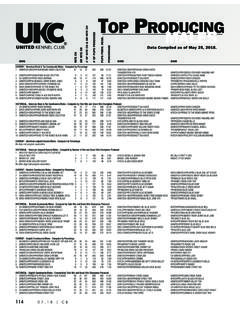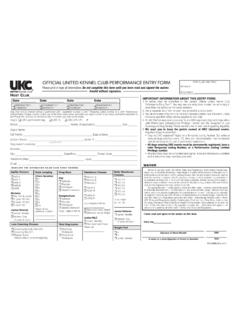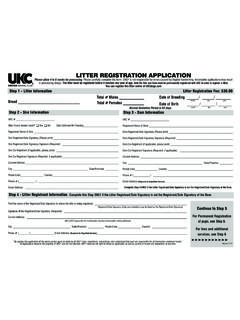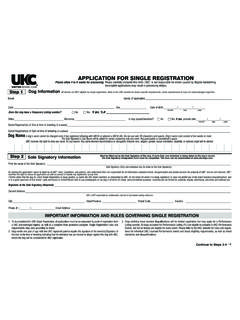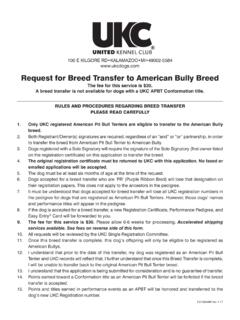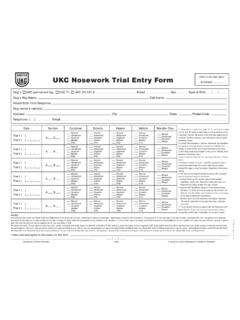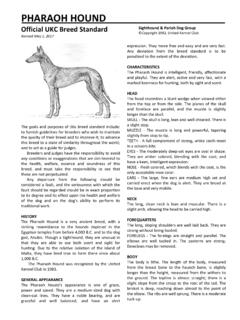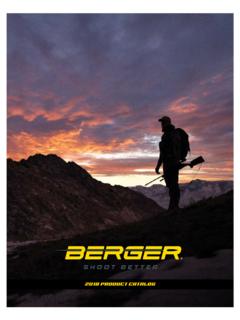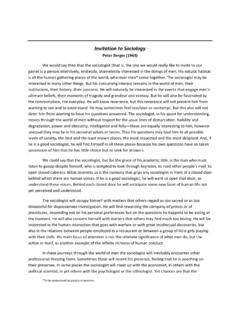Transcription of BERGER PICARD - United Kennel Club
1 BERGER PICARD Official UKC Breed Standard Revised October 1, 2012 Drawing reprinted with the permission of the artist, Evelyne Labit The goals and purposes of this breed standard include: to furnish guidelines for breeders who wish to maintain the quality of their breed and to improve it; to advance this breed to a state of similarity throughout the world; and to act as a guide for judges. Breeders and judges have the responsibility to avoid any conditions or exaggerations that are detrimental to the health, welfare, essence and soundness of this breed, and must take the responsibility to see that these are not perpetuated. Any departure from the following should be considered a fault, and the seriousness with which the fault should be regarded should be in exact proportion to its degree and its effect upon the health and welfare of the dog and on the dog s ability to perform its traditional work.
2 HISTORY The BERGER PICARD , named for the Picardie region in northeast France, is one of the oldest French breeds of sheep-herding dogs. Some scholars believe the breed was introduced by the Celts, while others claim it is descended from dogs of Asian tribes who invaded Europe in the Middle Ages. Some experts insist that this breed is related to the more well-known Briard and Beauceron, while others suppose it shares a common origin with Dutch and Belgian Shepherds. Although the BERGER PICARD made an appearance at the first French dog show in 1863, the breed s rustic appearance did not lead to popularity as a show dog. The two World Wars nearly caused the extinction of the BERGER PICARD and it is still rare, even in France.
3 The BERGER PICARD was recognized by the United Kennel club on January 1, 1994. GENERAL APPEARANCE The BERGER PICARD is a medium-sized, well-muscled dog, slightly longer than tall, with a distinctive rough coat, erect ears, and a natural tail that normally reaches to the hock and is carried with a slight J-curve at the tip. The BERGER PICARD should be evaluated as a working sheep-herding dog, and exaggerations or faults should be penalized in proportion to how much they interfere with the dog s ability to work. Disqualifications: Unilateral or bilateral cryptorchid. CHARACTERISTICS Britain has fewer predators and its sheep are less tame than in France. While British sheep traditionally lived outdoors in enclosed pastures, French sheep were usually grazed in an open pasture each day and returned each evening to a stable or enclosure.
4 These differences resulted in significant variations in the temperament and herding style of British and French dogs. The BERGER PICARD shares many characteristics with the Briard, the Beauceron, and the other continental herding breeds. Because of the French practice of grazing in unenclosed areas, often adjoining land planted with crops, the BERGER PICARD developed a herding style referred to as boundary or tending. This contrasts with the fetching style of the British herding dogs. Because of the increased threat of predators, French shepherds preferred a herding dog with a strong protective instinct that has led many of the more well-known continental herding breeds into police work.
5 The BERGER PICARD is a lively, energetic, affectionate dog that is still primarily used in France for herding. Their intelligence and protective instincts make them suitable as guard dogs as well. They are excellent family companions and very good with children. Disqualifications: Viciousness or extreme shyness. HEAD The head is free of wrinkles and proportional to the size of the dog. The skull and muzzle are of equal length, parallel to one another, and joined at a very Herding Dog Group Copyright 1998, United Kennel club slight stop. There is a slight median furrow between the bony arches over the eyes. SKULL - The skull is broad and slightly domed. It is covered with harsh-textured hair approximately 1 inches in length, which causes the skull to appear nearly flat when viewed from the front.
6 The cheeks are just slightly rounded. The hair above the eyes falls forward, forming rough eyebrows that are not trimmed nor are they so thick or long as to obscure the eyes. Faults: Eyebrows absent or too full. Skull too flat or too domed. Forehead too flat or too steep. MUZZLE - Viewed from above, the muzzle tapers slightly from the stop to the nose, but is powerful and never snipey. In profile, the bridge of the muzzle is straight. Lips are thin and tight with dark pigment. The hair on the muzzle forms a distinct moustache and beard. Faults: Absence of moustache or beard. Pendulous lips. Absence of pigment in lips. TEETH - The BERGER PICARD has a complete set of evenly spaced, white teeth meeting in a scissors bite.
7 Faults: Missing up to two premolars. Level mouth. Serious Faults: Missing up to four premolars. Disqualifications: More than four missing teeth. Overshot or undershot. NOSE - The nose is large and always black. Disqualification: Nose any color other than black. EYES The eyes are of medium size, oval, and set on a horizontal axis. Eye color is brown, with the darkness of the color varying with the color of the coat, but never lighter than hazel. The eye rims are tight-fitting and black. The expression is intelligent and confident. Serious Faults: Eyes set obliquely. Eyes too light. Disqualifications: Wall eyes. Non-matching eyes. EARS Ears are of moderate size (approximately 3 inches tall), set rather high, and always carried naturally erect.
8 They are broad at the base and slightly rounded at the tips. From the front, the outer edge of the ear points straight up, although it may point slightly outward and still be acceptable. Faults: Ears taller than 5 inches. Ears set too low or too close together. Outer edge of ear that points inward toward the tip. Disqualification: Ears not fully erect. NECK The neck is long but strong and muscular, blending smoothly into well-laid-back shoulders. The head is carried proudly erect. Faults: Neck too thin and weak. Neck too short and thick. Ewe neck. Dewlap. FOREQUARTERS The shoulder blades are long, smoothly muscled, and moderately laid back. FORELEGS - The forelegs are straight and strong, with slightly sloping pasterns.
9 The elbows are neither close to the body nor out, but are set on a plane parallel to the body. Faults: Pastern too steep; down in pastern. BODY The body is slightly longer than tall. The ribs are well sprung out from the spine, forming a strong back, then curving down and inward. The chest reaches no deeper than the elbows and extends in a gently rounded oval in front of the forelegs. The line of the back is straight. The loin is well-muscled and broad. The croup is slightly sloping and blends into the hindquarters in a gentle curve. The belly is slightly tucked up. HINDQUARTERS The angulation of the pelvis and femur is in balance with the angulation of the forequarters.
10 HIND LEGS - The hind legs are long and well muscled. The stifle and hock joints are moderately angulated. Rear pasterns are strong, lean, and of moderate length. Viewed from any angle, they are parallel to one another and perpendicular to the ground. When standing naturally, rear legs are spaced moderately apart and are set neither too far out behind the dog nor under. FEET Feet are compact, well-knit, and round in shape. Toes are well-arched. Pads are firm and supple. Nails are strong and dark in color. Double dewclaws on the rear legs may be present, but are not preferred. TAIL The tail is a natural extension of the topline. The tail is never docked; is thick at the base, and tapers to the tip.
